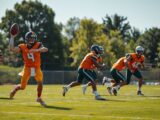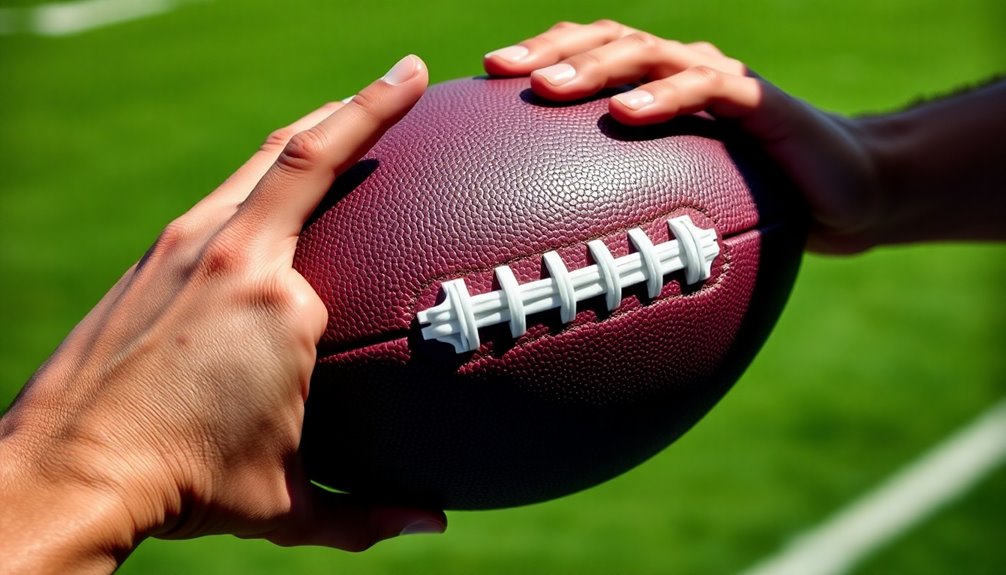
How to Hold a Football: Tips for Perfect Technique
January 4, 2025To hold a football perfectly, start by placing your index finger near the top of the ball, keeping a slight gap between your palm and the ball for better control. Use your ring finger and pinky on the laces for stability, ensuring that three fingers grip the laces. Fingers should wrap securely around them with your palm cradling the ball. Your stance matters too; position your feet wider than your shoulders and keep your knees slightly bent. Engaging your hips will enhance your throw. Want to elevate your technique further? There's a lot more to explore that can refine your game.
Grip Principles for Quarterbacks
When you pick up a football as a quarterback, nailing your grip is fundamental for success on the field. A proper grip involves placing your index finger at the top of the ball while limiting palm contact. This technique helps you utilize your fingertips and the first joint, giving you better control and accuracy when throwing a football. Additionally, having a strong cardiovascular endurance can enhance your overall performance during games. Consistent practice is crucial for refining your grip technique and developing technical skills on the field.
Your thumb should form an L shape beneath the knuckle to enhance grip strength, which is essential for a clean release and increased snap speed. Aim for a slight gap between your palm and the ball; this guarantees your grip feels secure but not overly tight.
For the best results, you'll want three fingers on the laces. Position your index finger near the top, while your middle finger often goes in the first lace for added stability.
Mastering these grip principles, including proper finger placement, is crucial. Remember, you want your index finger to be the last to touch the ball at release. This attention to detail will help you achieve a consistent spiral and improve your accuracy in throws, making you a more effective quarterback. Additionally, developing mental toughness is vital for maintaining focus during practice and games.
Stance Fundamentals for Throwing
A solid stance is vital for quarterbacks looking to throw the ball effectively. Start by positioning your feet about one inch wider than your shoulders. This provides a stable base for throwing. Keep your knees slightly bent; this flexibility guarantees you're ready to move when it's time to release the ball. Distribute your weight primarily on your dominant foot, which helps in transferring power from your lower body to your upper body. Incorporating endurance training methods into your conditioning routine can boost your overall stamina, allowing you to maintain form throughout the game.
When preparing to throw, remember the stance fundamentals. Pull the ball back at a ninety-degree angle with your throwing arm. This positioning optimizes your throwing mechanics and enhances your accuracy. Engaging in footwork drills can further enhance your balance and efficiency during the throw.
As you initiate your throw, engage your hips to rotate. This hip rotation is essential for maximizing power generated from your lower body, greatly improving the effectiveness of your pass.
Finally, verify you've properly gripped the ball throughout this process. Your grip will influence your control and precision during the throw. By focusing on these foundational elements, you'll enhance your overall throwing technique and performance on the field. Additionally, understanding diverse playing styles can provide insights into how to adapt your technique for different opponents, enhancing your strategic advantage.
Measuring Pass Quality
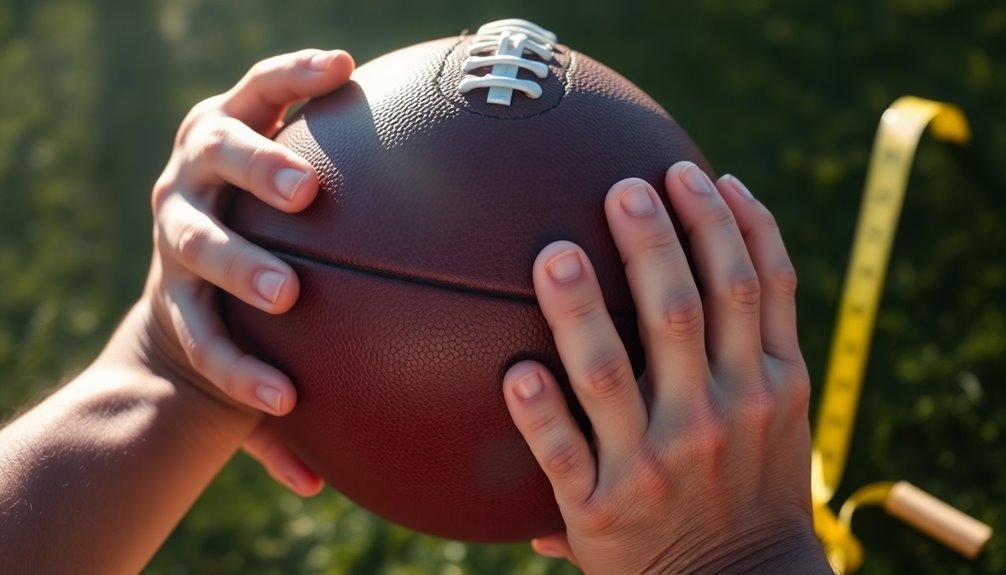
When you're measuring pass quality, focus on two key aspects: accuracy to your target and the tightness of your spiral.
Snap speed plays a critical role, as a quicker release can make all the difference in avoiding defensive reactions. To effectively counteract defenders, proper spacing is essential to maintain offensive momentum. Additionally, understanding effective communication among teammates can enhance the execution of your passes.
Consistency in your grip and technique is essential, impacting both the speed and trajectory of your throws. Additionally, data-driven strategies can be applied to analyze the effectiveness of your passes and identify areas for improvement.
Accuracy and Spiral Tightness
To achieve ideal pass quality, focus on accuracy and spiral tightness. Your grip on the ball is vital; it influences both your stance and overall throwing mechanics. Make certain your fingers are spread comfortably on the laces, while the ball rests snugly against the palm of your hand. This grip allows for better control, essential when you're throwing a perfect spiral.
As you prepare to throw, pay attention to your wrist flick and finger placement. A tight spiral reduces air resistance, helping the ball travel faster and more accurately to its target. Practice this technique regularly to develop consistency; the more familiar you become with your grip and stance, the more your performance will improve.
Don't underestimate the importance of practice. Focus on refining your grip and overall technique to enhance both accuracy and spiral tightness. Regular drills will help you fine-tune these aspects, making your passes more effective over time.
Snap Speed Importance
While you might focus on grip and stance to improve your throwing mechanics, snap speed plays an essential role in measuring pass quality. A faster release allows you to evade pressure and deliver the ball before defenders can react.
To enhance your snap speed, you need to guarantee that your grip of the football is solid yet flexible, allowing for a quick shift into your throwing motion.
When you practice your grip techniques consistently, you'll notice a measurable increase in your snap speed. This improvement will lead to more accurate and timely passes, vital in tight coverage situations.
The quality of your pass—its accuracy and spiral tightness—is greatly influenced by your ability to achieve peak snap speed.
Consistency in Technique
A quarterback's success hinges on the consistency of their technique, which directly impacts pass quality. To consistently grip the football effectively, focus on your fingers on the laces. The correct position of your index finger can dramatically enhance your throw, ensuring a clean release and accurate trajectory.
When you properly hold the ball, your stance and grip should remain uniform throughout your practice sessions. This consistency allows for better mechanics and improves the accuracy and tightness of your spiral.
Regularly practicing these principles not only refines your technique but also builds confidence. A faster snap speed at release, achieved through a steady grip and stance, makes your passes more challenging for defenders to intercept.
NFL Football Manufacturing Insights
When it comes to NFL footballs, you might be surprised by the intricate craftsmanship that goes into each Wilson Duke leather game ball. These footballs are handcrafted using premium materials designed to guarantee high quality and durability during gameplay. The production process is rigorous, with multiple quality control checks to confirm consistency across all balls. Proper equipment, like soccer cleats, enhances performance and helps athletes maintain stability on the field. Additionally, soccer cleats may fit differently than regular shoes, making it essential for athletes to find the right size for optimal performance.
Material selection plays a significant role in enhancing performance and feel, which is essential for your football grip. The specific lacing technique used in each ball contributes considerably to optimal grip and control during throws. This attention to detail allows you to focus on your technique, knowing that the ball you're gripping is built for precision. Additionally, understanding soccer cleat sizing can help athletes choose the right footwear for improved performance on the field.
Understanding the meticulous manufacturing process can deepen your appreciation for the equipment you rely on. When you hold that ball at release, remember that every stitch and material choice is aimed at improving your throwing mechanics.
Training Camp Preparation
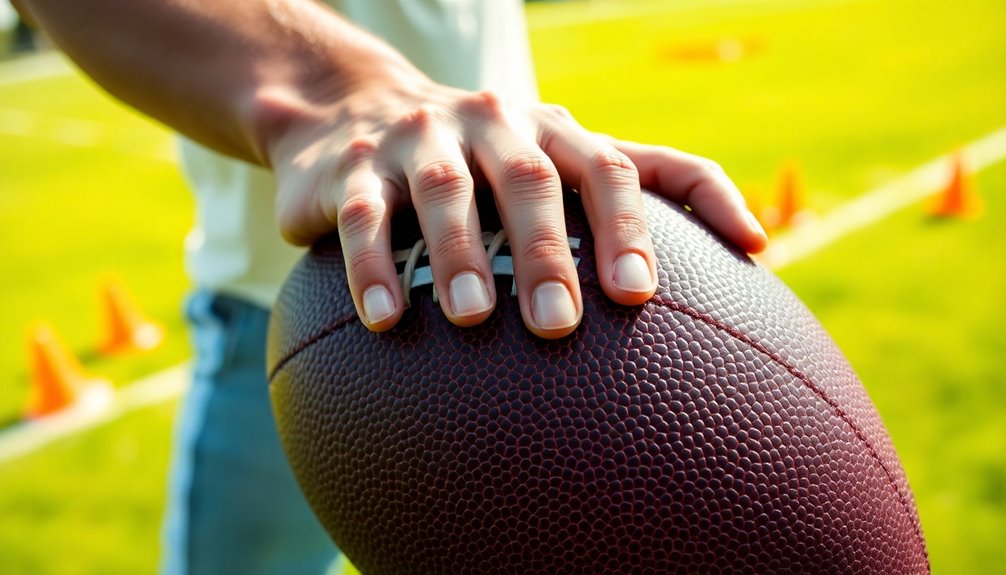
Training camp serves as an important period for NFL players to sharpen their skills and enhance their game. During this time, you'll focus on drills that refine your grip and throwing mechanics, essential for throwing a perfect spiral. The consistent practice of grip and stance principles helps you develop a perfect football grip, which is critical for accuracy and pass quality. Incorporating dynamic warm-up routines enhances your overall performance and prevents injuries during training. Incorporating speed and agility drills can also significantly improve your overall athleticism, making your throws more effective.
In collaborative practices with coaches, you'll gain valuable insights into tactical execution while honing your arm motion. These sessions allow you to assess what feels comfortable and effective in your grip, experimenting with different finger placements and stances. It's during these drills that you'll notice improvements in how you hold the football.
Additionally, the camaraderie built with teammates fosters a supportive environment where you can share tips and strategies. This interaction not only boosts your confidence but also enhances your overall technique. Incorporating elements of speed training can also improve your throwing power and precision, essential for making long passes under pressure.
Embrace this opportunity to focus on the fundamentals; mastering your grip and arm motion during training camp lays the groundwork for success in the season ahead. You'll be well-equipped to perform at your best when it's time to take the field.
Importance of Route Running
Route running is essential for building timing with your quarterback, ensuring every pass is executed flawlessly.
By mastering hand positioning techniques and enhancing your coordination, you set yourself up for successful catches.
When you focus on these skills, you'll elevate your overall performance on the field.
Timing With Quarterback
A receiver's success hinges on their ability to develop timing with the quarterback, making route running a vital skill in football. Running routes at game speed is essential for this synchronization. The more you practice, the better you'll anticipate the quarterback's throws, improving your overall execution. Repetitions build coordination, making it easier for you to gauge when and where to break on your route.
Proper hand placement while running routes creates a clear target for the quarterback, facilitating accurate passes. Keeping your arms slightly bent and hands at chest height prepares you to catch the ball while also allowing quick adjustments based on its location. This readiness is essential; when you're in sync with the quarterback, it elevates the entire offense.
Building trust and communication with the quarterback through practiced routes enhances your performance in games. When both you and the passer know what to expect, it creates a rhythm that's tough for defenses to disrupt.
Hand Positioning Techniques
Mastering effective hand positioning techniques plays a significant role in your overall route running. When you hold the ball, proper hand placement creates a reliable target for the quarterback, enhancing timing and accuracy. Keep your arms slightly bent and your hands at chest height. This posture guarantees you have a good grip and ready control for the catch.
As you run your routes, adjust your hand position based on the ball's location. Point your fingers up for high throws and flip your hands down for low ones. This flexibility improves your catching success and makes you more reliable on the field.
Practicing your hand positioning techniques while running routes at game speed allows you to refine your skills in real-time scenarios. Consistency is key; the more you practice, the more you'll reinforce muscle memory. This leads to improved performance when it matters most.
Enhancing Coordination and Execution
In the heat of the game, enhancing coordination and execution in your route running is essential for success. To throw a football accurately, you need to create a reliable target for your quarterback. This starts with running routes at game speed, which develops timing and rapport with the passer. The more you practice route running drills, the better you'll get at coordinating your movements and executing plays effectively.
Focus on your hand positioning while running routes. Keeping your arms slightly bent and your hands at chest height prepares you to catch the ball, no matter where it's thrown. Remember, your hand position should adjust based on the ball's trajectory; fingers pointed up for high passes and hands flipping down for low ones increase your chances of making successful catches.
Mastering these fundamental skills not only improves your performance but also boosts your confidence on the field.
As you refine your route running, you'll find that both you and your quarterback can synchronize better, leading to a more dynamic and effective offense. Embrace the practice, and watch your game elevate!
Catching Techniques for Receivers
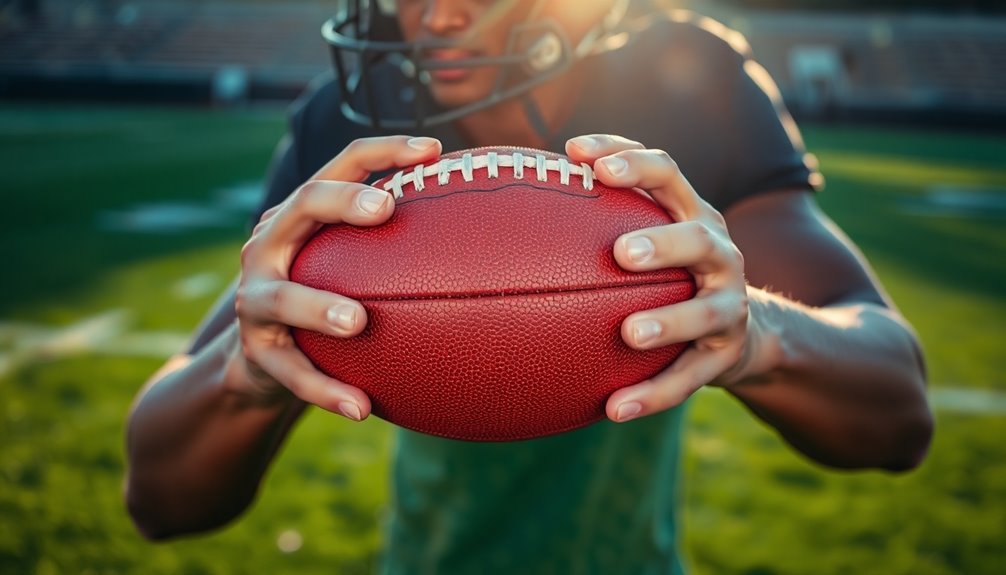
Catching a football effectively relies on proper technique and hand positioning. To enhance your catching skills, focus on these key techniques to guarantee a firm grip and control:
- For balls above the waist, position your fingers pointing up with your thumbs touching to create a secure catching surface.
- Always catch with your hands first before bringing the ball into your body, which helps maintain a firm grip and reduces the chance of drops.
- When receiving balls below the waist, flip your hands down with your pinky fingers together to maintain stability and control during the catch.
- Consistent practice and adjusting your hand positioning based on ball location are essential for improving your catching success.
Five Points of Contact
To securely hold a football, you need to focus on five key points of contact: your fingertips, palm, forearm, bicep, and chest. Each of these areas plays a crucial role in ensuring the ball stays firmly in your grip.
Start with your fingers, which should wrap around the ball's laces, providing a solid initial hold. Your palm then cradles the ball, distributing pressure evenly to enhance stability.
Next, engage your forearm and bicep to create a strong support structure. Your forearm should align with the ball, while your bicep helps anchor it against your body.
Finally, your chest acts as a secondary point of contact, further securing the ball as you prepare to throw or receive.
Practicing these five points of contact regularly will reinforce your muscle memory, allowing you to handle the ball with confidence during gameplay.
You'll find that when you feel all five points in contact, your grip becomes more stable, letting you focus on your throwing or receiving mechanics without worrying about dropping the ball.
This technique is essential for improving your overall performance on the field.
Factors Affecting Catching
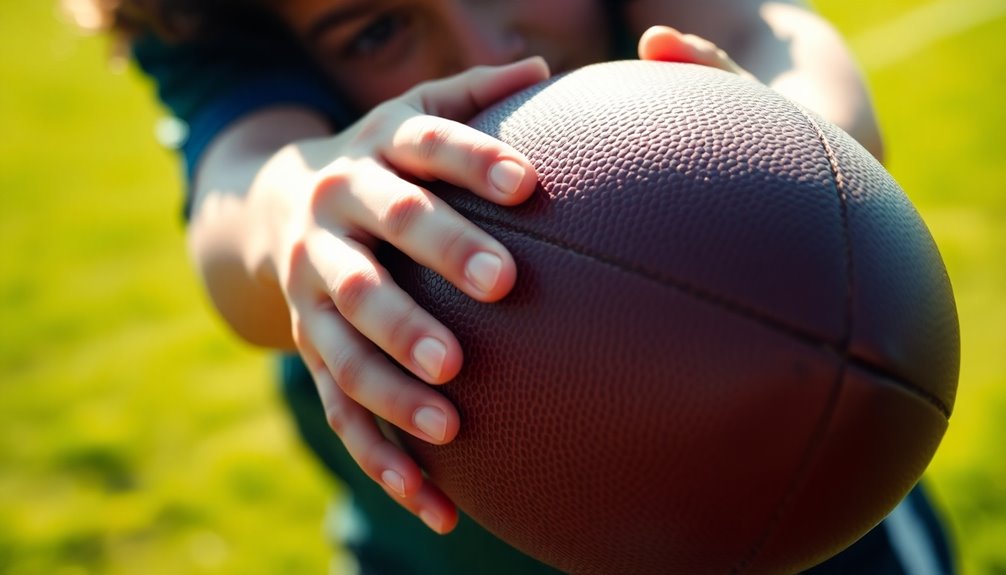
Holding the football securely sets the foundation for effective catching, but several factors can influence your success in this skill.
To enhance your catching ability, pay attention to these key elements:
- Body Position: Align your body with the incoming ball to improve catchability. Proper positioning makes all the difference.
- Flexibility in Catching: Be ready to adjust your hand positioning based on where the ball is—whether it's above or below your waist. Adaptability is essential.
- Defensive Coverage: Understand that defensive players can complicate your catches. You'll need to tweak your technique according to the situation and pressure you face.
- Trust and Rapport: Build a strong connection with your quarterback. Effective communication and timing during plays can lead to more successful catches.
Continuous Skill Improvement
Improving your football skills requires a commitment to continuous practice and refinement. Regularly focusing on your grip and stance techniques is essential for developing muscle memory, which enhances your passing accuracy and control.
As you work on these fundamentals, you'll notice significant improvements in your throwing mechanics.
Participating in football camps can be a game-changer. These camps provide expert guidance and tailored drills that zero in on grip and throwing skills, leading to accelerated skill development.
To maximize your practice sessions, set specific, measurable goals. This way, you can track your progress and stay motivated to improve consistently.
Engage in drills that emphasize proper grip, wrist position, and follow-through. These targeted exercises will help you refine your technique, making your throws more effective.
Additionally, don't hesitate to explore various resources, such as online tutorials and coaching clinics. These platforms can offer valuable insights and new techniques to enhance your football skills continually.
Techniques for Grip and Placement
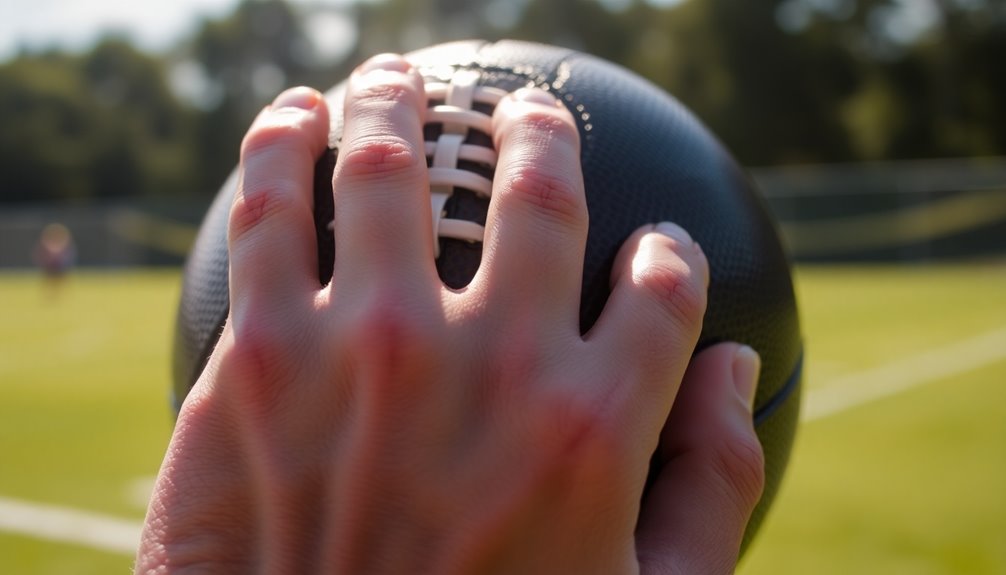
Mastering the grip and placement of a football is vital for executing precise throws. To effectively hold the football, you'll want to make certain that your fingers are spread across the laces, with your thumb stabilizing the ball.
The placement of your fingers is essential, so consider the following techniques:
- Position your index finger near the top of the ball for better control.
- Use your ring finger and pinky on the laces for ideal stability.
- Maintain a slight gap between your palm and the ball to enhance grip and allow for a clean release.
- Confirm that your index finger is the last to touch the ball during release for improved spin and accuracy.
Experiment with the number of fingers you use and the overall grip style to find what feels most comfortable for you.
This will help you develop a technique that suits your hand size and throwing mechanics. By refining your grip and assuring proper contact with the ball, you'll be well on your way to achieving that consistent spiral and precision in your throws.
Common Throwing Mistakes
Even with a solid grip and proper placement, mistakes can still creep into your throwing technique. One common error is an incorrect grip. If you're holding the ball too tightly or loosely, it can lead to inconsistent control, affecting both the accuracy and spiral of your throws.
Another issue often arises from a poor stance. An unbalanced or overly wide base can disrupt your timing, resulting in inaccurate passes. Pay attention to how you position yourself; a stable stance is vital for effective throws.
Additionally, overstriding while throwing can throw off your momentum, causing a loss of power and accuracy.
Don't forget to scan the field for open receivers. Failing to do so limits your options and can lead to missed opportunities for successful passes.
Finally, neglecting your follow-through can weaken your throws. Completing the motion is essential for achieving both velocity and accuracy.
Practice Strategies for Success
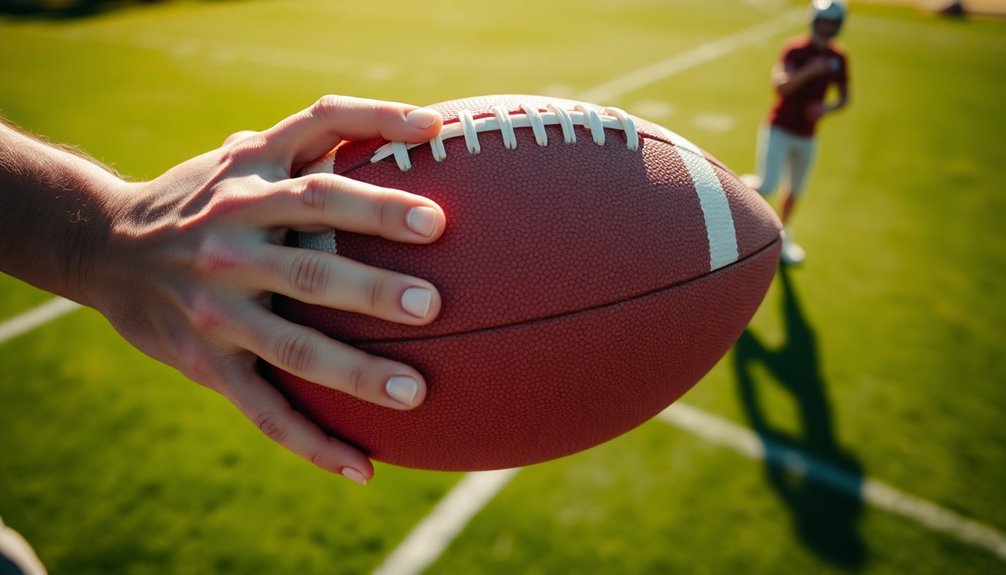
To achieve success in holding and throwing a football, you should integrate targeted practice strategies into your routine. Focusing on specific elements can notably enhance your grip and throwing mechanics. Here are some effective strategies to take into account:
- Regular Drills: Engage in drills that emphasize grip, wrist position, and follow-through to improve your throwing mechanics and accuracy.
- Video Analysis: Record your throwing sessions to analyze your technique, pinpointing areas needing improvement for targeted adjustments.
- Coaching Feedback: Work closely with coaches to receive constructive feedback, refining your mechanics while incorporating strength training to enhance arm and shoulder stability.
- Set Goals: Establish specific, measurable goals for each practice session to track your progress and guarantee continuous improvement in your grip and throwing skills.
Additionally, don't forget to incorporate catching practice alongside your throwing drills. This combination strengthens your grip and boosts overall performance in game situations.
Conclusion
By mastering your grip and stance, you'll transform your throwing technique into a powerful weapon on the field. Remember, each practice session is a step toward perfecting your craft, like chiseling a masterpiece from raw stone. Keep refining your skills, learn from your mistakes, and embrace the journey. With dedication and the right techniques, you'll not only elevate your game but also enjoy the thrill of every pass. Get out there and let your passion shine!


